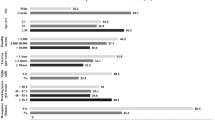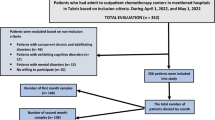Abstract
This study was designed to investigate the prevalence and type of sexual dysfunction (SD) in healthy sexually active Ghanaian men of fertile age. Sexual functioning was determined in 300 healthy Ghanaian men with the Golombok Rust Inventory of Sexual Satisfaction (GRISS) questionnaire leaving in Kumasi metropolis, between December 2009 and April 2010. All men had a steady heterosexual relationship for at least 2 years before enrollment in the study. Of the 300 men selected, 255 (85%) completed the survey; the overall prevalence of SD in these subjects was 66%. The most prevalent areas of difficulty were infrequency (70.2%), premature ejaculation (64.7%), dissatisfaction with sexual acts (61.2%), impotency (59.6%), nonsensuality (59.2%), noncommunication (56.9%) and avoidance (49.0%). There were positive correlation between SD, impotence, dissatisfaction and age. The prevalence rate of SD in Ghanaian men is high and related to age.
This is a preview of subscription content, access via your institution
Access options
Subscribe to this journal
Receive 8 print issues and online access
$259.00 per year
only $32.38 per issue
Buy this article
- Purchase on Springer Link
- Instant access to full article PDF
Prices may be subject to local taxes which are calculated during checkout

Similar content being viewed by others
References
Ayta IA, McKinlay JB, Krane RJ . The likely worldwide increase in erectile dysfunction between 1995 and 2025 and some possible policy consequences. BJU Int 1999; 84: 50–56.
Bancroft J . The biological basis of human sexuality. In: Michael Sinason (ed) Human Sexuality and its Problems. Churchill Livingstone: Edinburgh, 1989, pp 12–127.
Pepe F, Garozzo G, Pepe P . Incidence of sexual dysfunction in healthy sexually active sicilian women of fertile age spontaneously attending a private Gynaecologist for routine examination. J Obstet Gynaecol 1991; 11: 277–280.
Rust J, Golombok S . The GRISS: a psychometric instrument for the assessment of sexual dysfunction. Arch Sex Behav 1986; 15: 157–165.
Rust J, Golombok S . The Golombok Rust Inventory of Sexual Satisfaction (GRISS) [Manual]. NFER–Nelson: Windsor, England, 1986.
Rust J, Golombok S . The Golombok-Rust Inventory of Sexual Satisfaction (GRISS). Br J Clin Psychol 1985; 24 (Pt 1): 63–64.
Cohen J . Statistical Power Analysis for the Behavioral Sciences. Academic Press: New York, 1977.
Laumann EO, Paik A, Rosen RC . Sexual dysfunction in the United States: prevalence and predictors. JAMA 1999; 281: 537–544.
Reyes LR, Meininger JC, Liehr P, Chan W, Mueller WH . Anger in adolescents: sex, ethnicity, age differences, and psychometric properties. Nurs Res 2003; 52: 2–11.
Feldman HA, Goldstein I, Hatzichristou DG, Krane RJ, McKinlay JB . Impotence and its medical and psychosocial correlates: results of the Massachusetts Male Aging Study. J Urol 1994; 151: 54–61.
Martin-Morales A, Sanchez-Cruz JJ, Saenz de Tejada I, Rodriguez-Vela L, Jimenez-Cruz JF, Burgos-Rodriguez R . Prevalence and independent risk factors for erectile dysfunction in Spain: results of the Epidemiologia de la Disfuncion Erectil Masculina Study. J Urol 2001; 166: 569–574; discussion 574–565.
Braun M, Wassmer G, Klotz T, Reifenrath B, Mathers M, Engelmann U . Epidemiology of erectile dysfunction: results of the ‘Cologne Male Survey’. Int J Impot Res 2000; 12: 305–311.
Lyngdorf P, Hemmingsen L . Epidemiology of erectile dysfunction and its risk factors: a practice-based study in Denmark. Int J Impot Res 2004; 16: 105–111.
Corty EW, Guardiani JM . Canadian and American sex therapists’ perceptions of normal and abnormal ejaculatory latencies: how long should intercourse last? J Sex Med 2008; 5: 1251–1256.
Miller SA, Byers ES . Actual and desired duration of foreplay and intercourse: discordance and misperceptions within heterosexual couples. J Sex Res 2004; 41: 301–309.
Schiavi RC, Schreiner-Engel P, Mandeli J, Schanzer H, Cohen E . Healthy aging and male sexual function. Am J Psychiatry 1990; 147: 766–771.
Acknowledgements
We are grateful to Derrick Apful and Emmanuel Tim Donkoh and also the staff of Faculty of Allied Health Sciences for their technical expertise.
Author information
Authors and Affiliations
Corresponding author
Ethics declarations
Competing interests
The authors declare no conflict of interest.
Additional information
Authors’ contributions
Conception and Design: Nafiu Amidu, William KBA Owiredu.
Acquisition of Data: Nafiu Amidu, William KBA Owiredu, Eric Woode, CKG Sarpong.
Analysis and Interpretation of Data: Nafiu Amidu, Eric Woode, Otchere Addai-Mensah, Abass Alhassan.
Drafting the Article: Nafiu Amidu, Otchere Addai-Mensah, Abass Alhassan, CKG Sarpong.
Revising It for Intellectual Content: Nafiu Amidu, William KBA Owiredu, Eric Woode, CKG Sarpong.
Final Approval of the Completed Article: Nafiu Amidu, William KBA Owiredu, Eric Woode, Otchere Addai-Mensah, Abass Alhassan, CKG Sarpong.
Rights and permissions
About this article
Cite this article
Amidu, N., Owiredu, W., Woode, E. et al. Prevalence of male sexual dysfunction among Ghanaian populace: myth or reality?. Int J Impot Res 22, 337–342 (2010). https://doi.org/10.1038/ijir.2010.24
Received:
Revised:
Accepted:
Published:
Issue Date:
DOI: https://doi.org/10.1038/ijir.2010.24
Keywords
This article is cited by
-
Sexual Behaviors and Sexual Perceptions of Portuguese Adults with Physical Disabilities
Sexuality and Disability (2021)
-
“With tramadol, I ride like a Jaguar”: a qualitative study of motivations for non-medical purpose tramadol use among commercial vehicle operators in Kumasi, Ghana
Substance Abuse Treatment, Prevention, and Policy (2020)
-
Prevalence and factors associated with erectile dysfunction among adult men in Moshi municipal, Tanzania: community-based study
Basic and Clinical Andrology (2020)
-
Perspectives of Portuguese People with Physical Disabilities Regarding Their Sexual Health: A Focus Group Study
Sexuality and Disability (2018)
-
Sexual dysfunction among diabetics and its impact on the SQoL of their partners
International Journal of Impotence Research (2017)



